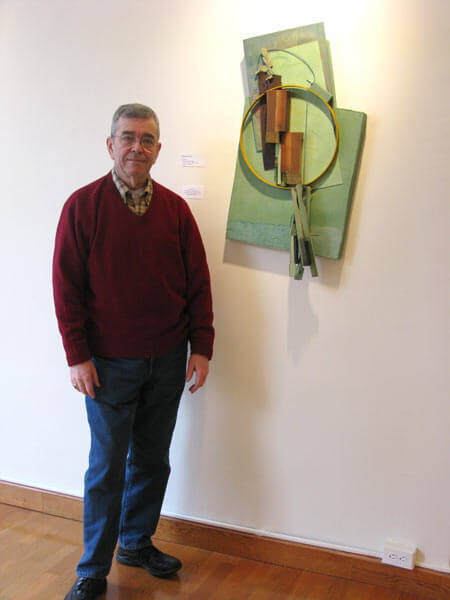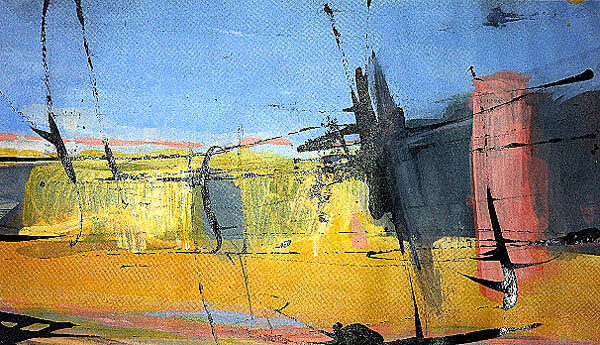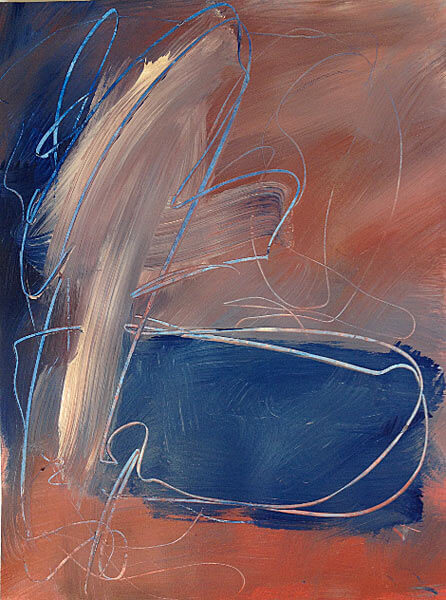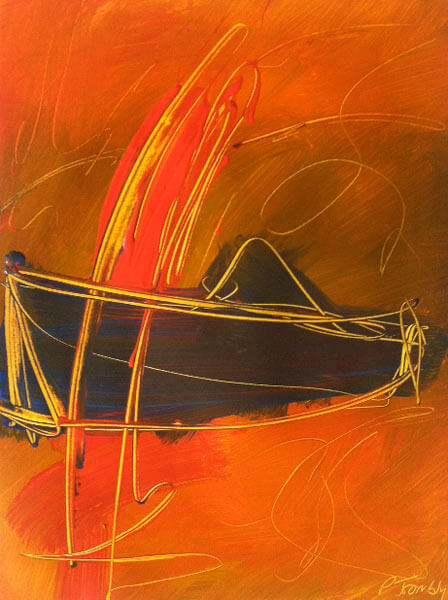By Allison Plitt
When one looks at any of Preston Trombly’s mixed-media collages from his “Sonatas” series, one gets the idea the artist had a very frustrating piano lesson, broke apart the piano with a hammer and then decided to put the parts of the instrument back together in an undefinable collection of bits and pieces.
In more professional terms, Trombly, who has a studio and displays his works at Diego Salazar Art Studios & Gallery 21-25 44th Ave. in Long Island City, is actually using a creative process called assemblage which consists of creating multi-dimensional compositions by putting together found objects.
Since Trombly is also an accomplished musician, some of his assemblages are created from parts of instruments such as piano keys and cello strings and he names some of his series of collages based upon music terminology like sonatas and toccatas. Trombly maintains, however, that his mixed-media assemblages titled “Nocturnes” are not influenced by music but by a series of paintings by American-born, British-based artist James McNeill Whistler who coined the term “nocturne painting” to describe works he created with twilight and evening scenes.
As piano keyboards and cello strings cling to his assemblages, the viewer does see the influence of music in Trombly’s life. Nevertheless, Trombly insists that he paints with the intention of making his artwork unrecognizable.
“My series of assemblages titled ‘Sonatas’ and ‘Toccatas’ use parts from an old piano. I paint and otherwise modify them so they become less identifiable as piano parts. I then use the resulting abstract shapes as compositional elements in each piece. This way, a viewer is more likely to become engaged visually with the work as a whole, rather than say ‘Oh, that’s a piano key over there,’” he said.
To truly understand the intricacy of Trombly’s work, one must know more extensively about his musical background. Born in Hartford, Conn., Trombly grew up in a town just east of there called Manchester. When he was younger, he learned to play the cello, saxophone and piano. He earned his bachelors of music with honors from the University of Connecticut and his master of musical arts from Yale University’s School of Music.
“I was pretty involved in the music world,” Trombly said. “In graduate school I spent a summer studying up at the Tanglewood-Berkshire Music Center in Massachusetts with Leonard Bernstein and composer George Crumb and that was a pretty illuminating piece of my life.”
Besides being a fellow in composition and conducting at Tanglewood, Trombly received grants to study classical music from the National Endowment for the Arts and the New York State Council on the Arts.
Another notable achievement for Trombly was receiving a Guggenheim Fellowship to compose music in the 1970s. He is one of the youngest people to ever receive one.
During this time he was composing classical music and conducting orchestral concerts all over the United States and Europe, but when he returned to New York City after one of his trips, he became interested in the visual arts for the first time.
“During my Guggenheim Fellowship year, a friend had given me a camera and I got hooked on black and white photography,” Trombly said. “I also got involved in doing my own darkroom work and wanting to emphasize certain parts of a photo by rubbing the image with my hands during the developing process. It was maybe five or six years later that I followed through on my impulse to get my hands involved by learning how to draw and that feeling went all the way back to the camera work in the mid-1970s,” he said. “I also composed music in that year as well and for a while afterwards there was an overlapping period when I was working both in music and the visual arts. After a while my musical work dwindled away as the visual arts took over.”
In his mid-30s, Trombly wanted to learn how to draw, so he took classes at the New York’s Art Students League. Because he became good at drawing quickly, he became more involved in visual arts especially within the last decade.
Although he lives in Chelsea, he has a short commute to Long Island City where he works in his studio.
Trombly believes that there are many similarities between composing music and making visual art.
“Even though the materials are obviously very different, the way composers and painters work is very similar,” he said. “Composers and artists both make choices about their materials and how those materials relate to each other in the context of the work.
“Composers make decisions about which musical events will happen when: When will this melody begin? What instruments will play? How loud will this chord be? In other words, what happens when? Visual artists make decisions about which colors, shapes, materials appear where,” he said. “Where will this shape go? What color will it be? Where will this line connect to another? In other words, what happens where?”
Besides assemblages, more recently Trombly has been working on paintings. One series of notable paintings he created on newspaper. Initially he took the actual newspaper photographs and then created abstract images from then. He tied together the elements of the drawings with a black reed pen. From these smaller landscapes, he has been able to create larger paintings which he calls “Imaginary Landscapes.”
Trombly attempts to describe his creative process when he paints.
“I go to the studio with an overall idea or maybe a general concept of what I want to do, but if I pre-plan too much, the piece just comes out looking very studied and self-conscious,” he said. “Each work takes on a life of its own and when that happens, I know I’m on to something, but I don’t ever know that until I’m working on a piece and it takes over. It tells me what to do.”
Although he is currently immersed in his painting, he still has the opportunity to revert back to his past and contribute to the music community. Presently, Trombly hosts radio shows on two different SiriusXM channels. On the Pops Classical Channel 75, he does a morning program. On the Symphony Hall Channel 76, he presents afternoon shows which are comprised of symphonies, chamber music pieces and concertos.
“A large part of who I am revolves around music. On SiriusXM radio, I am fortunate to be able to share my experience, knowledge and love of classical music with a large number of classical music devotees across the country,” Trombly said. “Another large part of who I am revolves around my work in the visual arts. Both together paint a more complete picture of who I am.”
For more information about Preston Trombly and his artwork, you can visit his website at www.prestontrombly.com.



































